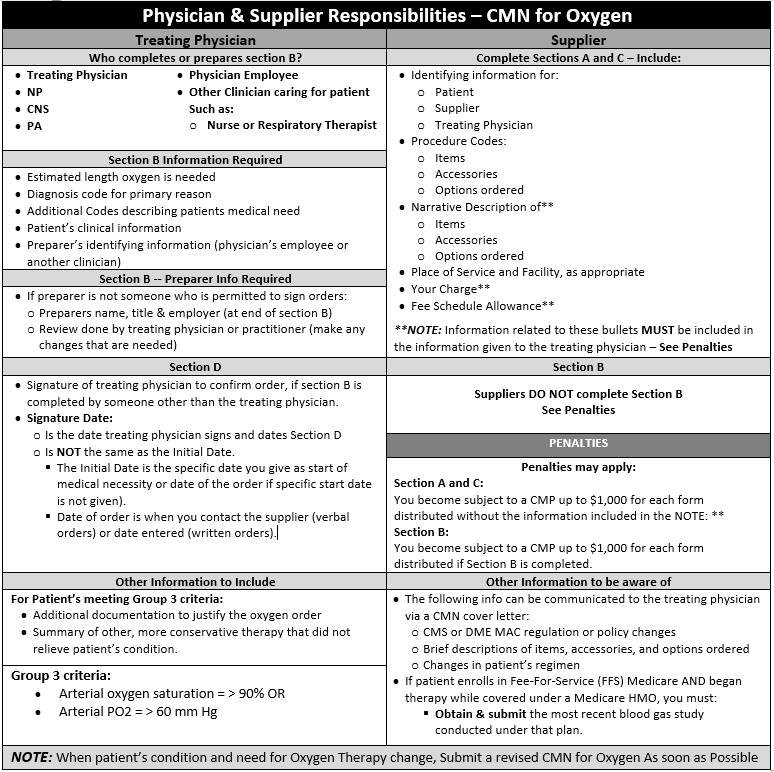
Home Oxygen Therapy -- CMN for Oxygen
June 14th, 2018 - Raquel Shumway
The Certificate of Medical Necessity (CMN) for Oxygen is a required form that helps to document the medical necessity for oxygen therapy. It also documents other coverage criteria for the oxygen use. For payment on a home oxygen claim, the information in the supplier’s records or the patient’s medical record must be substantiated with the information in the CMN.
Completing this form is considered a service to the patient and any associated fees are included in the fee for service. Therefore, no fee is to be charged for completing a CMN.
According to the MLN Home Oxygen Therapy Booklet, a CMN can be submitted electronically, if:
- All privacy, security, and electronic signature rules and regulations published by CMS and the Department of Health and Human Services are followed.
- All of the following are identical to what is printed on the back of the hard copy
- Questions/wording
- Same sequence
- Same pagination
- Identical instructions/definitions
- Question sets are not combined and
- Hard copy of document is maintained on file
Requirements for submitting a CMN for Oxygen can be found in the MLN Booklet. This includes the time frames for recertification, blood gas study testing requirements, and physician visit requirements. Criteria that you must meet to furnish oxygen items and equipment for home use is also included for the Initial 36 months, months 37-60 and month 61 and after. See the following page listing for this and other information.
- Requirements for Initial submission (page 14)
- Requirements for submitting Recertification (page 15)
- Oxygen Items and Equipment:
- Equipment table (page 19)
- Oxygen Contents (page 24)
- Maintenance of equipment (page 27)
- Relocation and Travel (page 28)
Both the Treating Physician and the Supplier have responsibilities for filling out the CMN. The table below identifies those responsibilities.

There are several forms and requirements necessary for home oxygen therapy. Please see our article Home Oxygen Therapy for more information and links to other requirements.
###
Questions, comments?
If you have questions or comments about this article please contact us. Comments that provide additional related information may be added here by our Editors.
Latest articles: (any category)
Artificial Intelligence in Healthcare - A Medical Coder's PerspectiveDecember 26th, 2023 - Aimee WilcoxWe constantly hear how AI is creeping into every aspect of healthcare but what does that mean for medical coders and how can we better understand the language used in the codeset? Will AI take my place or will I learn with it and become an integral part of the process that uses AI to enhance my abilities?
Specialization: Your Advantage as a Medical Coding ContractorDecember 22nd, 2023 - Find-A-CodeMedical coding contractors offer a valuable service to healthcare providers who would rather outsource coding and billing rather than handling things in-house. Some contractors are better than others, but there is one thing they all have in common: the need to present some sort of value proposition in order to land new clients. As a contractor, your value proposition is the advantage you offer. And that advantage is specialization.
ICD-10-CM Coding of Chronic Obstructive Pulmonary Disease (COPD)December 19th, 2023 - Aimee WilcoxChronic respiratory disease is on the top 10 chronic disease list published by the National Institutes of Health (NIH). Although it is a chronic condition, it may be stable for some time and then suddenly become exacerbated and even impacted by another acute respiratory illness, such as bronchitis, RSV, or COVID-19. Understanding the nuances associated with the condition and how to properly assign ICD-10-CM codes is beneficial.
Changes to COVID-19 Vaccines Strike AgainDecember 12th, 2023 - Aimee WilcoxAccording to the FDA, CDC, and other alphabet soup entities, the old COVID-19 vaccines are no longer able to treat the variants experienced today so new vaccines have been given the emergency use authorization to take the place of the old vaccines. No sooner was the updated 2024 CPT codebook published when 50 of the codes in it were deleted, some of which were being newly added for 2024.
Updated ICD-10-CM Codes for AppendicitisNovember 14th, 2023 - Aimee WilcoxWith approximately 250,000 cases of acute appendicitis diagnosed annually in the United States, coding updates were made to ensure high-specificity coding could be achieved when reporting these diagnoses. While appendicitis almost equally affects both men and women, the type of appendicitis varies, as dose the risk of infection, sepsis, and perforation.
COVID Vaccine Coding Changes as of November 1, 2023October 26th, 2023 - Wyn StaheliCOVID vaccine changes due to the end of the PHE as of November 1, 2023 are addressed in this article.
Medicare Guidance Changes for E/M ServicesOctober 11th, 2023 - Wyn Staheli2023 brought quite a few changes to Evaluation and management (E/M) services. The significant revisions as noted in the CPT codebook were welcome changes to bring other E/M services more in line with the changes that took place with Office or Other Outpatient Services a few years ago. As part of CMS’ Medicare Learning Network, the “Evaluation and Management Services Guide” publication was finally updated as of August 2023 to include the changes that took place in 2023. If you take a look at the new publication (see references below),....

